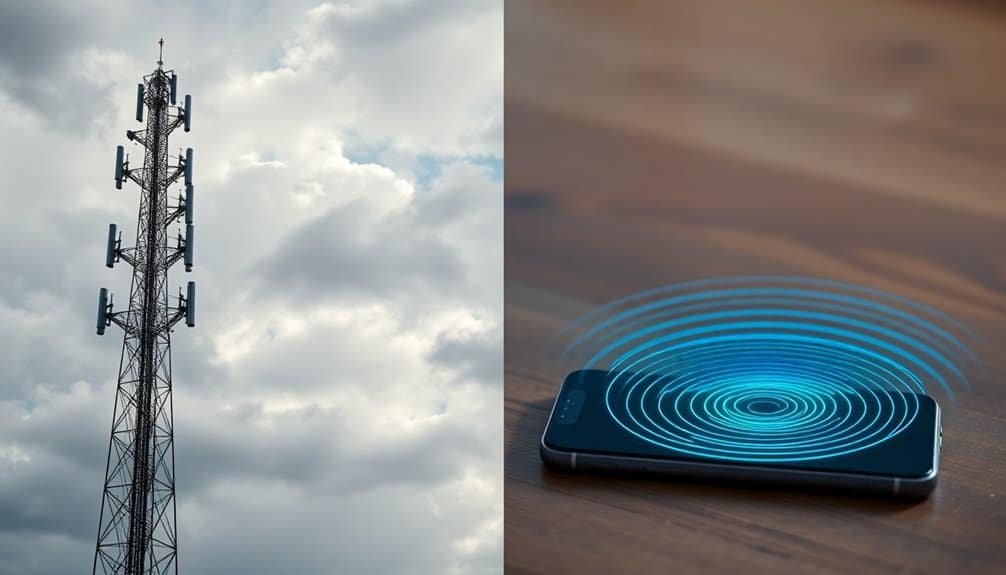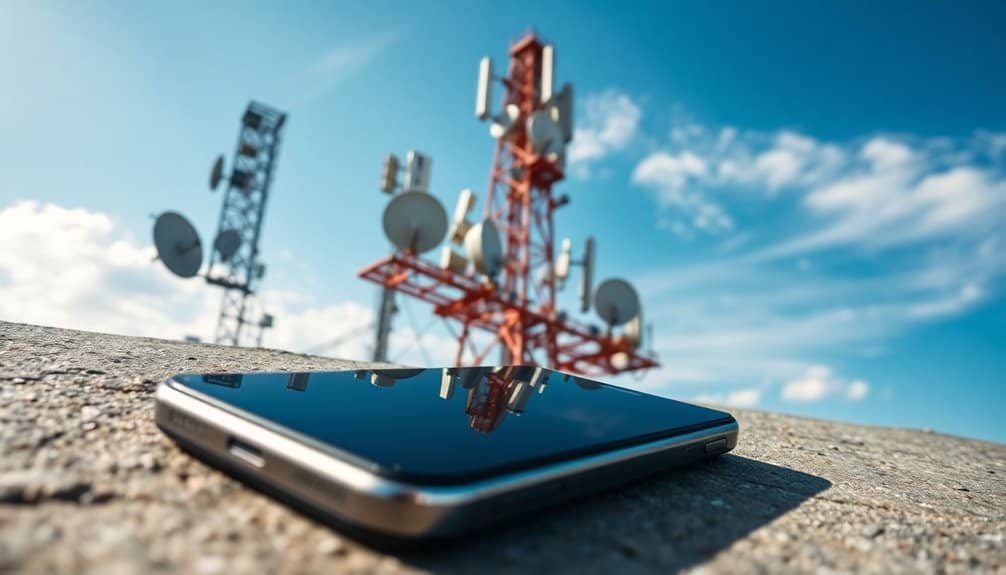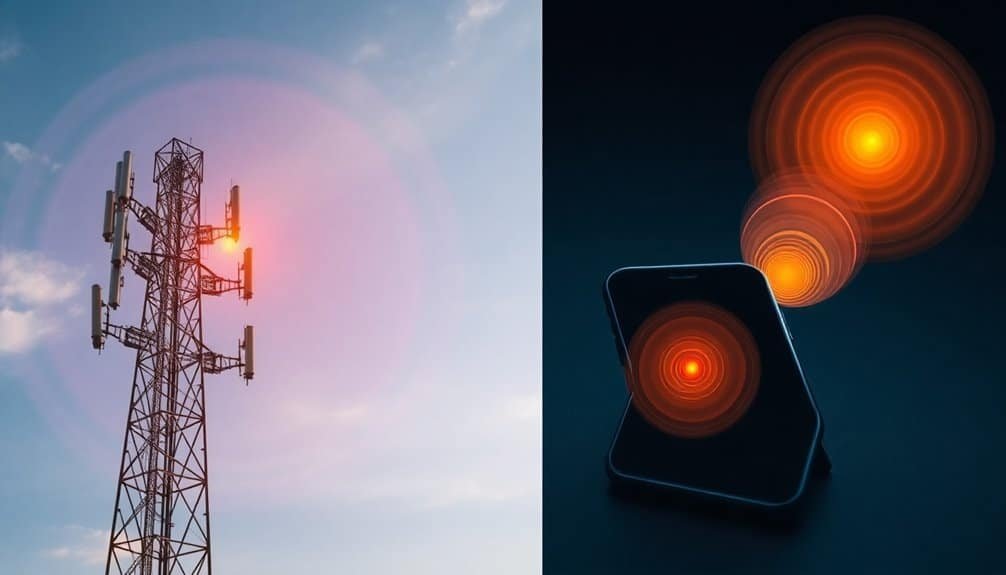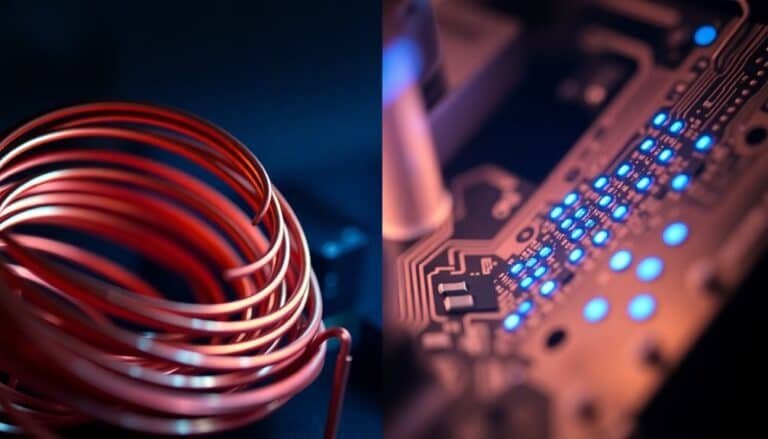Comparing EMF Impact: Cell Tower Vs Cell Phone
Cell towers emit RF energy at lower power densities, operating at frequencies from 600 MHz to 2.5 GHz, which provides broader coverage but lower exposure levels. In contrast, cell phones, operating at higher frequencies (1700 to 2100 MHz), can lead to higher localized EMF exposure during use.
Understanding these differences is crucial in assessing potential health risks from continuous exposure. Further exploration of these technologies and their impacts is essential.
Disclaimer: As an affiliate, I may collect a share of sales from the links on this page.
Understanding EMF Sources

When you interact with electrical devices, you’re exposed to electromagnetic fields (EMFs), which are areas of energy produced by electricity. EMFs consist of electric and magnetic fields. Electric fields arise from voltage or electric charge, while magnetic fields emerge from electricity flowing through wires.
Common sources of EMFs include electric power lines, home appliances, and office equipment. Generally, EMFs are classified as non-ionizing radiation, viewed as harmless, unlike ionizing radiation. Their strength decreases with distance. While some studies suggest potential links to childhood leukemia, most household exposures are considered safe, with the World Health Organization indicating no confirmed health risks. However, exposure to EMFs from personal mobile phone use is notable as it contributes significantly to radiofrequency EMF exposure, especially in crowded environments. This is particularly concerning because cell phones emit radiation whether they are charging or not.
Frequency Ranges of Cell Towers and Cell Phones
Electromagnetic fields arise not just from general electrical appliances, but also particularly from telecommunication devices.
Cell towers and cell phones utilize distinct frequency ranges, impacting coverage and signal strength.
- Low-Band Frequencies: Both use 600 MHz, 700 MHz, and 850 MHz for wider coverage.
- Mid-Band Frequencies: Cell towers use 2.5 GHz and C-band (3.7 GHz), while cell phones often operate on 1700/2100 MHz. Different bands allow for efficient use of the spectrum by multiple carriers.
- High-Band Frequencies: Higher frequencies, like 24 GHz and above, are mainly reserved for urban 5G services.
These frequency selections guarantee effective communication based on location and user demand.
Health Concerns Related to EMF Exposure

While many individuals rely on cell towers and cell phones for daily communication, concerns about health impacts from their electromagnetic field (EMF) exposure have grown.
Research suggests both sources emit RF radiation linked to increased cancer risk, including brain cancer. Prolonged exposure may cause genetic damage and neurological symptoms like headaches and sleep disturbances. Additionally, studies have shown that significant health concerns arise from the effects of base station antennas on humans. Increased exposure to radio frequency radiation from numerous small antennas in urban areas exacerbates these risks.
Significantly, children are more vulnerable to these effects. Continuous exposure from cell towers compounds risks, especially in residential areas.
Scientists recommend reducing exposure, particularly for children, due to potential long-term health issues. The ongoing debate about safety limits reflects the urgency of public health awareness.
Measurement Techniques for EMF Levels
To accurately assess electromagnetic field (EMF) levels from both cell towers and cell phones, various measurement techniques are utilized.
- EMF Meter Types: Use high-frequency meters to measure EMF power density in mW/m², covering frequencies from 800 MHz to 2500 MHz.
- Multi-Sided Measurements: Conduct measurements from all sides of cell towers at 50m and 100m distances to guarantee thorough data.
- Real-Time Monitoring: Some meters can detect EMF levels in real-time while a cell phone is in use, comparing it against background levels for detailed insights. Accurate measurements are crucial for understanding safe EMF levels to minimize potential health risks.
These methods allow for accurate and reliable data collection essential for evaluating EMF exposure.
Comparing EMF Intensity: Cell Towers vs. Cell Phones

When evaluating the intensity of electromagnetic fields (EMF) emitted by cell towers and cell phones, it’s clear that both sources present different characteristics and exposure scenarios.
Cell towers emit variable levels of EMF, influenced by antenna count and distance, with power density measurements ranging from low to high. In contrast, cell phones primarily emit extremely low frequency magnetic fields, which decrease considerably with distance.
While exposure from towers generally decreases as you move away, phone emissions vary based on usage. Both sources emit non-ionizing radiation, but their intensity and impact depend heavily on specific environmental factors and user patterns.
Public Perception and Environmental Impact
How do public perceptions shape our understanding of electromagnetic fields (EMF) from cell towers and cell phones? These perceptions influence trust and regulatory standards, reflecting varied awareness and concerns.
- Awareness: Some communities express strong concerns about potential health risks, including cancer and neurological issues.
- Media Influence: Media coverage often emphasizes EMF controversies, shaping public opinion inconsistently.
- Expert Disagreement: Scientific consensus is lacking, as experts frequently clash over health impacts and risk levels, creating confusion.
The Evolution of Technology and EMF
As technology has advanced, our understanding of electromagnetic fields (EMF) has greatly evolved. Historical beginnings date back to Thales of Miletus in 600 BCE, revealing the first insights into electricity.
Christian Doppler’s 1842 discovery clarified wave propagation, while Faraday’s 1845 finding showed magnetic fields’ effects on light polarization. Maxwell’s 1864 equations unified electricity and magnetism, laying the groundwork for EMF comprehension.
The 20th century saw innovations like thermionic tubes, superconductivity in 1911, and microwave technology enhancing communication.
Modern advancements, culminating in mobile phones and cell towers, have dramatically increased EMF exposure, emphasizing the importance of ongoing research in this evolving field.
Regulatory Guidelines and Safety Standards
Given the rapid advancements in telecommunications technology, regulatory guidelines and safety standards for electromagnetic fields (EMF) have become critical.
These frameworks help protect the public. Here are key points to take into account:
- FCC Guidelines: The Federal Communications Commission (FCC) sets exposure limits for both cell towers and cell phones to maintain safety.
- MPE Limits: Maximum Permissible Exposure (MPE) levels control RF exposure, with distinct limits for public and occupational safety.
- International Standards: U.S. regulations align with international benchmarks, promoting uniform safety across borders.
Frequently Asked Questions
Can EMF Exposure From Cell Towers Affect Wildlife?
Yes, EMF exposure from cell towers can considerably affect wildlife. You’ll find that it disrupts reproduction, alters migration patterns, and impacts behaviors, potentially leading to long-term consequences for biodiversity and ecosystem health.
How Is EMF Exposure Measured at Home?
Measuring your home’s electromagnetic ambiance is straightforward! You’ll use a certified EMF meter, checking spots where you relax. Remember to observe variations throughout the day and make repeated measurements for a clearer picture of exposure levels.
Are There Products to Shield Against EMF Radiation?
Yes, there are various products designed to shield against EMF radiation, like metallic materials, carbon nanotubes, and polymer composites. However, you should evaluate their effectiveness and be cautious about potential health impacts and claims.
What Are the Symptoms of Overexposure to EMF?
Imagine you’re tossing and turning at night, restless and irritable. If you’ve experienced headaches, skin sensations, or difficulty concentrating, you might be dealing with symptoms of EMF overexposure—common complaints many people face today.
How Can I Reduce My Cell Phone’S EMF Emission?
To reduce your cell phone’s EMF emissions, use speakerphone or headphones, keep it away from your body, turn on airplane mode when not in use, and minimize usage in weak signal areas.
Conclusion
Understanding the EMF impact from cell towers and cell phones is crucial. Cell phones expose users to about 1.6 W/kg of body tissue, while cell towers emit EMFs averaging around 0.1 W/kg at typical distances. Recognizing these differences helps in making informed EMF exposure decisions.






